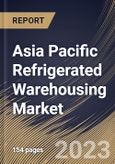A refrigerated warehouse utilizes a refrigeration system that aids in sustaining an environment and temperature suitable for each item being stored. In addition, the primary components of a cold storage area or a refrigerated warehouse include a refrigeration system, condensation receiver, expansion switch, evaporator, and compressors. In addition to food, refrigerated storage is necessary for blood samples, beverages, and other items.
Several industrial cold storage warehouses have been built in urban areas to satisfy quick delivery requirements. Companies are constructing taller warehouses due to the need to reduce high operating costs caused by expensive land in urban locations. This has necessitated the use of fall protection gear to minimize labour risk. Businesses are implementing sustainability and energy-efficiency initiatives to maximize energy efficiency. Continuously operating cooling equipment in a refrigerated warehouse consumes enormous quantities of energy, which can be expensive. Consequently, optimizing energy efficiency with technologies such as Thermal Energy Storage (TES) can reduce operating expenses.
The Asia Pacific region is undergoing rapid urbanization, with more people moving to urban areas. This trend has increased demand for processed and convenience foods requiring refrigerated storage and distribution. As incomes rise and lifestyles change, consumers in the Asia Pacific region are increasingly seeking convenience and fresh, healthy food options. This has driven the demand for refrigerated storage of perishable products. The expansion of supermarket chains, convenience stores, and hypermarkets in the Asia Pacific region has created a need for refrigerated warehousing to support their supply chains and ensure product quality. As a result, the above factors will lead the market expansion in the coming years.
The China market dominated the Asia Pacific Refrigerated Warehousing Market, By Country in 2022, and would continue to be a dominant market till 2030; thereby, achieving a market value of $23,328.3 million by 2030. The Japan market is experiencing a CAGR of 16.5% during (2023 - 2030). Additionally, The India market would exhibit a CAGR of 18% during (2023 - 2030).
Based on Application, the market is segmented into Food & Beverages, (Fish, Meat, & Seafood, Bakery & Confectionary, Fruits & Vegetables, Processed Food, Dairy Products, Fruit Pulp & Concentrates, and Others), Pharmaceuticals, (Vaccines, Blood Banking and Others) and Others. Based on Temperature Range, the market is segmented into Frozen (-18°C to -25°C), Chilled (0°C to 15°C), and Deep-frozen (Below -25°C). Based on Type, the market is segmented into Public and Private & Semi-Private. Based on countries, the market is segmented into China, Japan, India, South Korea, Singapore, Malaysia, and Rest of Asia Pacific.
The market research report covers the analysis of key stakeholders of the market. Key companies profiled in the report include Lineage Logistics Holdings, LLC, Americold Realty Trust, Inc, Burris Logistics, Tippmann Group, Nichirei Corporation, Conestoga Cold Storage, NewCold Cooperatief UA, United States Cold Storage, Inc. (Swire Pacific Limited), FreezPak Logistics and Confederation Freezers.
Scope of the Study
Market Segments Covered in the Report:
By Application- Food & Beverages
- Fish, Meat, & Seafood
- Bakery & Confectionary
- Fruits & Vegetables
- Processed Food
- Dairy Products
- Fruit Pulp & Concentrates
- Others
- Pharmaceuticals
- Vaccines
- Blood Banking
- Others
- Others
- Frozen (-18°C to -25°C)
- Chilled (0°C to 15°C)
- Deep-frozen (Below -25°C)
- Public
- Private & Semi-Private
- China
- Japan
- India
- South Korea
- Singapore
- Malaysia
- Rest of Asia Pacific
Key Market Players
List of Companies Profiled in the Report:
- Lineage Logistics Holdings, LLC
- Americold Realty Trust, Inc
- Burris Logistics
- Tippmann Group
- Nichirei Corporation
- Conestoga Cold Storage
- NewCold Cooperatief UA
- United States Cold Storage, Inc. (Swire Pacific Limited)
- FreezPak Logistics
- Confederation Freezers
Unique Offerings
- Exhaustive coverage
- The highest number of Market tables and figures
- Subscription-based model available
- Guaranteed best price
- Assured post sales research support with 10% customization free
Table of Contents
Companies Mentioned
- Lineage Logistics Holdings, LLC
- Americold Realty Trust, Inc
- Burris Logistics
- Tippmann Group
- Nichirei Corporation
- Conestoga Cold Storage
- NewCold Cooperatief UA
- United States Cold Storage, Inc. (Swire Pacific Limited)
- FreezPak Logistics
- Confederation Freezers








